|
|
Chorale Melodies used in Bach's Vocal Works
Allein Gott in der Höh sei Her
The German Gloria (in excelsis Deo) |
|
Melody & Text | Use of the CM by Bach | Use of the CM by other composers |
| |
|
Melody & Text: Zahn: 4457 | EKG: 131 (1480-1529) |
|
This melody is based in part on the Gregorian chant “Gloria in excelsis” from the Latin Late Medieval Liturgy and on a “Sanctus in festis duplicibus” of the “Graduale Romanum”. The first section (Stollen) of “Allein Gott in der Höh sei Ehr” is similar to a 10th century Easter song which subsequently spread to other countries. [No musical example available for the latter.] It was Nikolaus Decius (c1485-after 1546) who pulled together various existing melodic strands and probably used this melody with a slightly different text in Braunschweig in 1522. Unfortunately, the original sources of Decius’s melodies and texts from this period have been lost; this is why later dates such as 1525 (Rostock) are generally given where sources have confirmed his authorship. Nevertheless, Decius is considered to be the author and composer of the oldest Evangelical Lutheran chorales (Luther wrote his first chorale a year later). His [Decius’s] melodies are based on those used in the Latin Mass, but he reformed and reshaped them to reflect the style of the folksongs of his time. There are three chorales which can be traced back to him. They are (with the original Low German titles): 1. »Aleyne God yn der Höge sy eere«, 2. »Hyllich ys Godt de vader«, 3. »O Lam Gades vnschüldich« [“Allein Gott in der Höh sei Ehr”, "Heilig ist Gott der Vater”, and “O Lamm Gottes unschuldig”]. These chorales were designed to replace the “Gloria”, “Sanctus”, and “Agnus dei” of the Roman Mass and were to be sung by the congregation. Originally a firm supporter of Luther, Decius later sided more with reformed doctrine. This may explain why Luther later accepted only the Decius melody, but not his original text. Just what the differences in text may have amounted to is not clear, but certainly Luther’s task also involved translating the Low German into Luther’s language, Middle German (which later became the main basis for High German).
Here is an illustration which will allow the reader to compare the Decius German Gloria (probably already 1522) with the much older Gregorian chant, with an early contemporaneous version by Thomas Müntzer of the Easter Gloria from the German Mass (1524) and with Martin Luther’s German Gloria chorale “All Ehr und Lob” from 1537. |
|
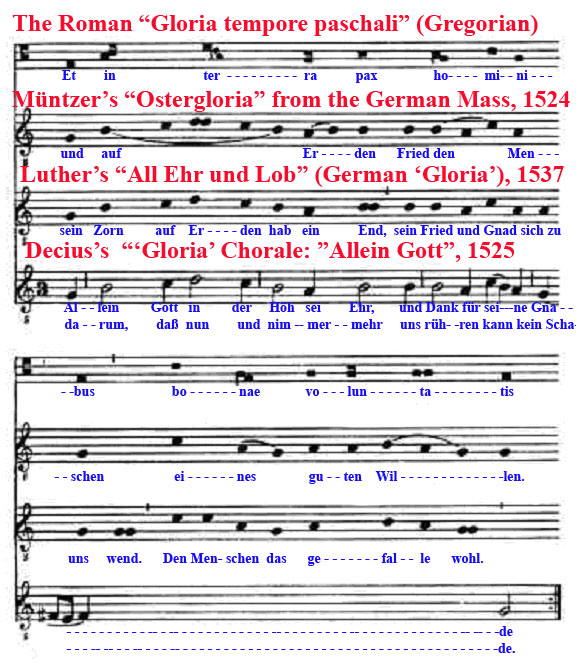
|
| |
|
Melody: |
|
It can be safely assumed that as the CM appears now, Decius is the composer who based sections of the CM (and, of course, most of the text as well) on the older chants which were part of the Latin liturgy. It may even have been possible that he was acquainted with one of the old Easter folksong based on the chant as well; however, he could just have easily worked from simply the Latin chant. |
| |
|
Texts: |
|
There are three CTs, which Bach used with this CM:
1. Allein Gott in der Höh sei Ehr | EKG: 131
The original CT of Decius was written in Low German. It is difficult to compare and contrast this with what is normally given as High German text in the hymnals. It is most probable that Luther had to translate from one dialect of German to another and that in the process, Luther not only had to change the spellings and the positions of words, but he would occasionally have had to change the choice of words as well. In any case, Luther modified the Decius text but kept the Decius melody.
2. Auf Christi Himmelfahrt allein | EKG: 83
This CR is listed as EKG 93 with a different melody (Es ist gewißlich an der Zeit). It was put into its final textual form by Ernst Sonnemann (1630-1670) and was based upon another text by Josua Wegelin (1604-1640). The latter was born in Augsburg and held a position there as pastor of the Barfüßerkirche ("Church of the Barefoot Monks"). He became a refugee twice during his lifetime with his final position as pastor being in Preßburg. Ernst Sonnemann was born in Ahlden (Löneburg) in 1630. As Deputy Headmaster of Schools, a position he assumed in Celle in 1658, he was the editor of the Lüneburg Hymnal in 1661, the same year that he became a pastor at the Cathedral St. Alexandri in the town of Einbeck where he died in 1670.
3 & 4. Der Herr ist mein getreuer Hirt | EKG:
This CT is a paraphrase of Psalm 23 by Wolfgang Meuslin, which appeared in print in Augsburg, 1530. BWV 112/1 NBA text is based upon verse 1 of this CT. Bach's text is very close to the original text from 1530. Mvts. 2-5 of BWV 112 are taken from verses 2-5 of Wolfgang Meuslin's original 5-verse CT.
This CT is not to be confused with the CT with the same incipit by Cornelius Becker (1598). Becker's CT is also a paraphrase of Psalm 23. Verse 1 of this CT was used by Bach in BWV 104/6 and BWV 85/3. It is not known by the authors of this page if Becker may have used Mesulin's 1st verse as the basis/inspiration for his version, neither it is known if he left the other verses of Mesulin's CT intact or wrote additional verses of his own.
Wolfgang Meuslin (Musculus) (1497-1563) was born in Diuze, Lorraine. At first he was a monk, then became a Catholic priest, later became an Evangelical pastor in Dorlisheim (Alsace). In 1539 he was a pastor at the Cathedral in Straßburg, then active in the Reformation movement in Augsburg after 1530. In 1548 he was driven away from there by the events of the Interim period and then became a professor of theology in Bern where he died in 1563. Still found in the EKG are his: Christe, der du bist Tag und Licht (based on a 6th-century Latin hymn Christe qui lux es et dies and of Der Herr ist mein getreuer Hirt (Psalm 23).
Cornelius Becker was born 1561 in Leipzig, became pastor at the St. Nicholas Church and a professor of theology at the University of Leipzig. As a counterpart to the already existing reformed Psalters, Becker versified all the Psalms in the manner of Luther and transformed them into German Lutheran chorales. He died in 1604. Still listed in the EKG are the following CTs by Becker: Komm her, mit Fleiß zu schauen (for weddings); Nun jauchzt dem Herren, alle Welt Psalm 100 based upon Becker's original but rewritten by David Denicke (1603-1680); Wohl denen, die da wandeln Psalm 119; Ich heb mein Augen sehnlich auf Psalm 121; Mit meinem Gott geh ich zur Ruh (1st verse only). |
| |
|
Other Wittenberg chorales |
|
Luther’s practice was also that of his immediate collaborators, whose chorales appeared with Luther’s in the earliest printed collections, and who together formed the ‘Wittenberg orbit’, named after the centre of Luther’s activities from 1512. Many of their chorales are still sung, notably Wo Gott der Herr nicht bei uns hält (EG 297) by Justus Jonas; Es ist das Heil uns kommen her (EG 342) by Paul Speratus; Ich ruf zu dir, Herr Jesu Christ (EG 343), sometimes attributed to Johann Agricola (c1494-1566); Johann Walter’s Wach auf, wach auf, du deutsches Land (EG 145); Erasmus Alber’s Christe, du bist der helle Tag (EG 469), based on the hymn Christe qui lux es et dies; Nun lob, mein Seel, den Herren (EG 289) by Johann Gramann (1487-1541) and Herr Christ, der einig Gotts Sohn (EG 67) by Elisabeth Cruciger (c1500–35), the first Reformation chorale to draw on the late medieval tradition of Jesus mysticism that became prominent in succeeding generations. (The melody of this chorale is derived from a mid-15th-century secular love song, Mein Freund möcht sich wohl mehren, in the Lochamer Liederbuch, and its text is based on the Christmas hymn of Aurelius Prudentius, Corde natus ex parentis.) Allein Gott in der Höh sei Ehr (EG 179) and O Lamm Gottes, unschuldig (EG 190.1) by Nikolaus Decius are important as versifications of the Gloria and Agnus Dei that are set to the original Gregorian melodies. Although Luther, for personal reasons, never included Decius’s chorales in the official Wittenberg hymnbooks, they soon became part of the standard German Mass Ordinary cycle.
Authors: Robert L. Marshall/Robin A. Leaver
Grove Music Online, © Oxford University Press 2006, acc. 3/5-06 |
| |
|
Liturgical reforms |
|
Luther’s liturgical reforms, which included both radical and conservative elements, preserved a continuity with existing liturgical music, while at the same time fostering new developments, particularly those related to the congregational chorale. In the Latin Formula missae Luther retained the traditional structure of the Mass, including Ordinary and Propers, which continued to be performed either as plainchant or polyphonically. This meant that mass settings by Catholic composers were still sung in the new evangelical liturgy and that Lutheran composers wrote new settings of the traditional Ordinary. But the theology of the Mass was radically reinterpreted: Luther, instead of viewing the Eucharist as a ‘sacrificium’, that is, an offering to God, understood it as a ‘beneficium’, a gift from God. By removing all elements that spoke of sacrifice, he effectively eliminated the Offertory and most of the Canon. The Verba testamenti (Words of Institution) were retained, but Luther regarded them as proclamation, not prayer, and preferred that they be sung rather than remain, as in the Roman Canon, mostly inaudible. Towards the end of the Formula missae Luther expressed the desire for congregational German hymns to be sung after the gradual, Sanctus and Agnus Dei, although at this stage only the Leisen (older vernacular folk-hymns; see: Leise in CM page Christ ist erstanden) were available for such use.
Three years after the Formula missae Luther issued the Deutsche Messe (1526), designed for use by congregations in smaller towns and cities. Other evangelical masses in the vernacular had already appeared in print, such as those of Caspar Kantz (1522) and Thomas Müntzer (1523/4), but Luther’s was to have much the greatest influence. Music is fundamental to the Deutsche Messe – of its 39 pages following the preface, 31 include musical notation that frequently fills the page. For this Mass, Luther collaborated with two of Friedrich der Weise’s leading musicians, Conrad Rupsch, the aged Kapellmeister, and Johann Walter, Rupsch’s younger colleague and eventual successor. The structure, while generally following the traditional Mass, represents a simplification of the traditional order: a simple threefold Kyrie replaced the ninefold form of the Latin Mass; the alleluia, gradual, sequence, Sursum corda and Preface were omitted; the prose Credo was replaced by the credal hymn Wir glauben all an einen Gott; the Lord’s Prayer with its introductory ‘paraphrase’ was brought forward to appear in the position of the traditional Preface; the Sanctus was expanded within a vernacular form that included the biblical context of Isaiah vi, Jesaja dem Propheten das geschah, and moved to the distribution of Communion, where it became an optional item along with the German Agnus Dei. The other music of the Deutsche Messe included (in sequence): in place of the introit, either a prose psalm (sung to a psalm tone) or a hymn; a collect (tone 8); the Epistle (tone 8), chanted to specific melodic formulae; the hymn Nun bitten wir den Heiligen Geist, sung in place of the gradual (hence the term Graduallied); the Gospel (tone 6), chanted to its own melodic formulae modelled on the Holy Week Passion tones; the Verba testamenti, similarly sung to the Gospel melodic formulae (tone 6); the German Sanctus, Jesus Christus, unser Heiland (Luther’s reworking of the Latin communion hymn attributed to Jan Hus), and the German Agnus Dei, sung as musica sub communione, that is, during the distribution of Communion.
Although the Deutsche Messe did not include a version of the Gloria in excelsis Deo, its use is confirmed by later practice. The omission from the Deutsche Messe in 1526 is almost certainly to be explained by the fact that the document was drawn up in December 1525, that is, during Advent, when the Gloria was customarily omitted. The vernacular translation by Nikolaus Decius, Allein Gott in der Höh sei Ehr (1523), quickly became the hymnic version in universal use. The Deutsche Messe thus established the principle of congregational, hymnic alternatives to the traditional liturgical Ordinary. After the German version of the Kyrie fons bonitatis appeared in 1537, appeared some primary liturgical hymns.
These chorales formed the basis of much of the liturgical music of virtually every generation of Lutheran composers, encompassing a wide variety of genres and forms of choral, vocal, organ and other instrumental music, a notable example being the first group of chorales in part 3 of J.S. Bach’s Clavier-Übung (1739).
Luther’s two liturgical forms were not mutually exclusive; neither was the later vernacular order intended to replace the Latin evangelical Mass. Latin was actively encouraged in the churches of towns and cities where there were Latin schools and/or universities. A substantial part of Luther’s strategy for the consolidation of the reforming movement was in a specific educational programme. The pre-existing Latin schools were reformed, and basic evangelical theology was taught alongside subjects such as grammar, rhetoric and music, the last being given high priority Both the theoretical and practical aspects of music were addressed, and the repertory that formed the basis of the teaching was also sung in the church to which the school was attached. The choir of school pupils (Kantorei), led by their music teacher (Kantor), who was also director of music in the church (see Rautenstrauch, 1907), sang the polyphonic liturmusic and led the congregation in singing the chorales. In this educational reform Luther provided the fundamental theology of music and Melanchthon the pedagogical principles and curricula; Johann Walter, who in 1529 became the first Lutheran Kantor in Torgau, composed much of the repertory; and Georg Rhau, in collaboration with Luther, Melanchthon and Walter, published a steady stream of music and music theory for church and school – 60 imprints appeared in the period 1528-48.
Many of the numerous Lutheran church orders of the 16th century were based on conflations of Luther’s two liturgies. The first part of the eucharistic rite (Hauptgottesdienst), the Ministry of the Word, in general approximated more closely to that of the Formula missae, being mostly in Latin, and the later part, the Ministry of the Sacrament, to that of the Deutsche Messe, being mostly in German. These macaronic liturgies frequently duplicated the Ordinary, whereby the German hymnic form, sung congregationally, would follow the Latin version sung by the choir. For example, Allein Gott in der Höh sei Ehr was sung after the Latin Gloria in excelsis Deo, or Wir glauben all an einen Gott after the Latin Credo. This admixture of Latin and German encouraged composers to integrate the texts and melodies of German hymns into their settings of both Ordinary and Proper, such as Christ ist erstanden, the Leise that Johannes Galliculus incorporated into the sequence and Agnus Dei of his Easter mass (published in Rhau’s Officia paschalia, 1539), and Allein Gott in der Höh sei Ehr interwoven within Johann Nicolaus Bach’s concerted Gloria in excelsis Deo (1716).
An examination of the different liturgical elements, together with their associated liturgical music, of the morning eucharistic Hauptgottesdienst and the afternoon Vespergottesdienst, as commonly found in the Lutheran church orders of the 16th century, reveal the distinctive features of Lutheran church music that were developed in a variety of ways in subsequent centuries.
Traditional monodic chant continued in use, often with revised texts (in either Latin or German) and in melodic forms customarily sung in Germany (see Ameln, Mahrenholz and Thomas, 1933-1974; Brodde, 1961; Mattfeld, 1966, appx IV). These chant forms were found either in locally prepared manuscript collections or in printed anthologies, such as Johann Spangenberg’s Cantiones ecclesiatica latinae … Kirchen Gesenge deutsch (1545, and later editions); Lucas Lossius’s Psalmodia, hoc est cantica sacra veteris ecclesiae selecta (1553, and later editions); and Johannes Keuchenthal’s Kirchen Gesenge latinisch und deudsch (1573).
Author: Robin A. Leaver
Grove Music Online, © Oxford University Press 2006, acc. 3/5-06 |
| |
|
Hymnal versions Bach may have known: |
|
An early 17th century hymnal |
|
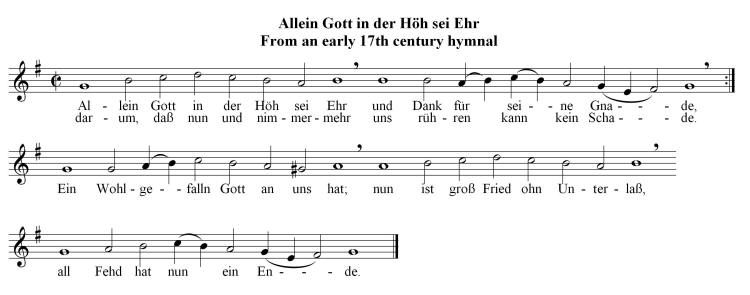
|
|
The Vopelius hymnal (1682) |
|
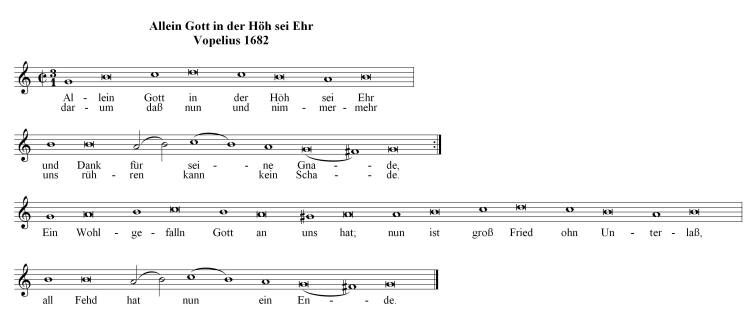
|
|
Composite CM form |
|

|
| |
|
Use of the Chorale Melody by Bach: |
|
Text 1: Allein Gott in der Höh sei Ehr | EKG: 131
Authors: Nikolaus Decius (1525) / Martin Luther |
|
Ver |
Work |
Mvt. |
Year |
Br |
RE |
KE |
Di |
BC |
Score |
Music Examples |
|
- |
BWV 260 |
- |
? |
249 |
12 |
249 |
2 |
F10:1 |
PDF |
Chorale (MG) [midi] |
|
BWV 260: Untexted probably from a lost cantata. |
|

|
| |
|
Text 2: Auf Christi Himmelfahrt allein | EKG: 83
Author: Ernst Sonnemann’s (1661) adaptation of Josua Wegelin’s (1636) „Auf Christi Himmelfahrt allein“ |
|
Ver |
Work |
Mvt. |
Year |
Br |
RE |
KE |
Di |
BC |
Score |
Music Examples |
|
1 |
BWV 128 |
Mvt. 1 |
1725 |
- |
- |
- |
- |
A76:1 |
- |
Mvt. 1 (YFM) [midi] | Mvt. 1 (Leusink) [ram] |
|
BWV 128/1: NBA I/12 Dürr p. 375 instrumental part |
|
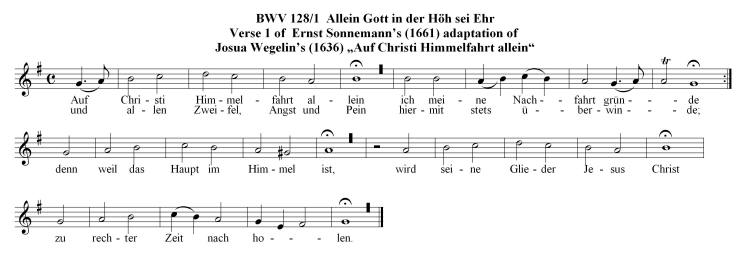
|
| |
|
Text 3: Der Herr ist mein getreuer Hirt | EKG:
Author: Wolfgang Meuslin (based on Psalm 23, 1530) |
|
Ver |
Work |
Mvt. |
Year |
Br |
RE |
KE |
Di |
BC |
Score |
Music Examples |
|
1 |
BWV 112 |
Mvt. 1 |
1731 |
- |
- |
- |
- |
A67:1 |
|
Mvt. 1 (Leusink) [ram] |
|
5? |
BWV 112 |
Mvt. 5 |
1731 |
312
352 |
14 |
353 |
101 |
A67:5 |
PDF |
Mvt. 5 (MG) [midi] | Mvt. 5 (Leusink) [ram] |
|
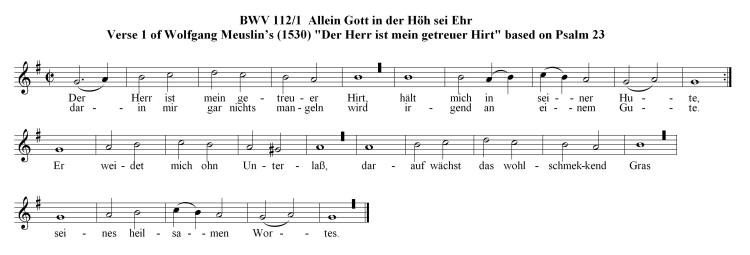
|
|

|
| |
|
Text 4: Der Herr ist mein getreuer Hirt | EKG:
Author: Cornelius Becker (verse 1, based on Psalm 23, 1598) |
|
Ver |
Work |
Mvt. |
Year |
Br |
RE |
KE |
Di |
BC |
Score |
Music Examples |
|
1 |
BWV 85 |
Mvt. 3 |
1725 |
- |
- |
- |
- |
A66:3 |
- |
Mvt. 3 (Leusink) [ram] |
|
1 |
BWV 104 |
Mvt. 6 |
1724 |
125
325 |
13 |
326 |
- |
A65:6 |
PDF | PDFv |
Mvt. 6 (MG) | Mvt. 6 (MG) ver [midi] | Mvt. 6 (Leusink) [ram] |
|
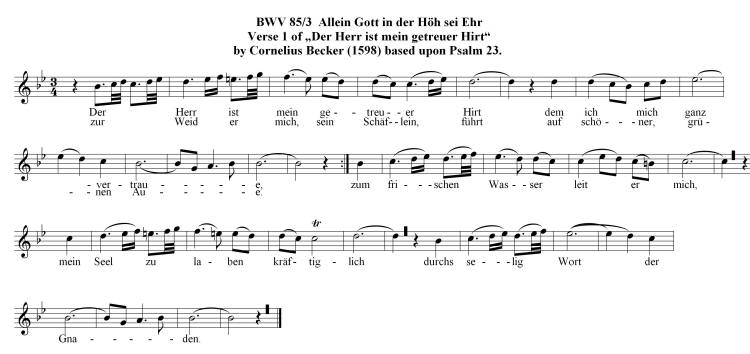
|
|

|
| |
|
Untexted: |
|
Ver |
Work |
Mvt. |
Year |
Br |
RE |
KE |
Di |
BC |
Score |
Music Examples |
|
- |
BWV 662 |
- |
|
- |
- |
- |
- |
K85 |
- |
Chorale [midi] | |
|
- |
BWV 663 |
- |
|
- |
- |
- |
- |
K86 |
- |
Chorale [midi] |
|
- |
BWV 664 |
- |
|
- |
- |
- |
- |
K87 |
- |
Chorale [midi] |
|
- |
BWV 675 |
- |
1739 |
- |
- |
- |
- |
K7 |
- |
- |
|
- |
BWV 676 |
- |
|
- |
- |
- |
- |
K8 |
- |
- |
|
- |
BWV 711 |
- |
1700/17 |
- |
- |
- |
- |
K140 |
- |
- |
|
- |
BWV 715 |
- |
|
- |
- |
- |
- |
K128 |
- |
- |
|
- |
BWV 716 |
- |
|
- |
- |
- |
- |
K141 |
- |
- |
|
- |
BWV 717 |
- |
|
- |
- |
- |
- |
K106 |
- |
- |
|
BWV 662: Chorale Prelude for Organ [BWV 651-BWV 668 Weimar with revision in Leipzig 1739-1750 NBA IV/2 „The Great Eighteen Chorales“]
BWV 663 Chorale Prelude for Organ (with melody highlighted)
BWV 664 Chorale Prelude (Trio) for Organ
BWV 675 Chorale Preludes from Part 3 of the Clavier Übung NBA IV/4
BWV 711 Chorale Preludes for Organ NBA IV/3
BWV 716 (not accepted by the NBA) |
|
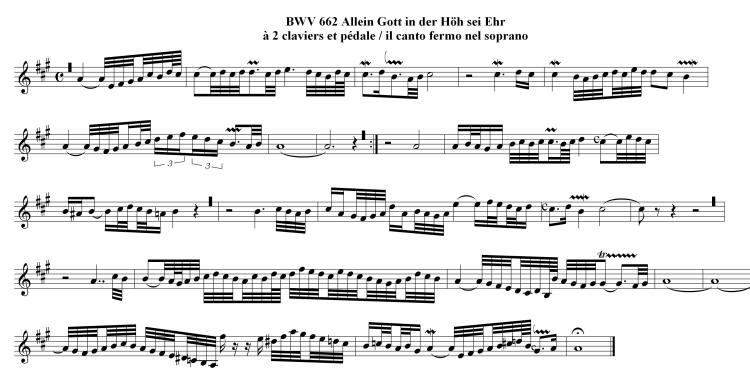
|
|
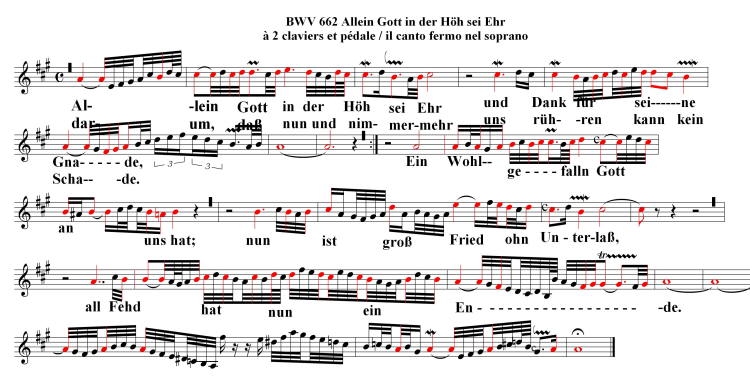
|
|
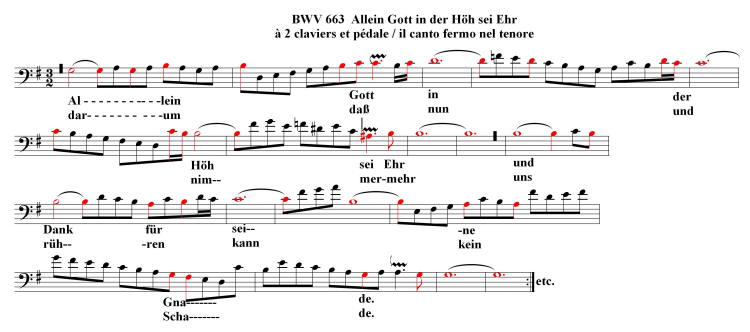
|
|

|
|
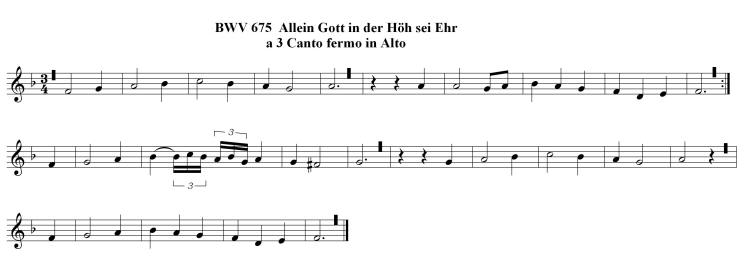
|
|
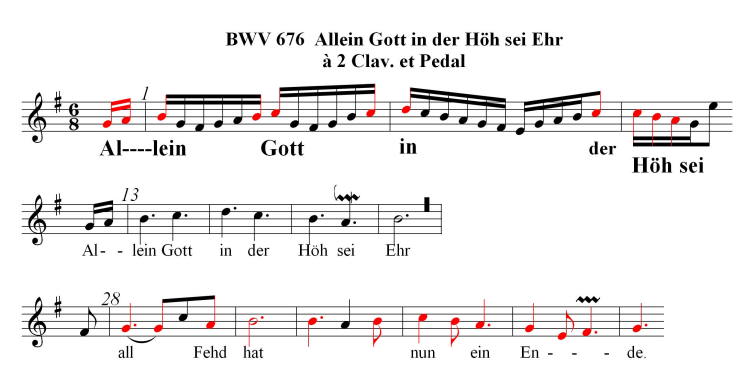
|
|
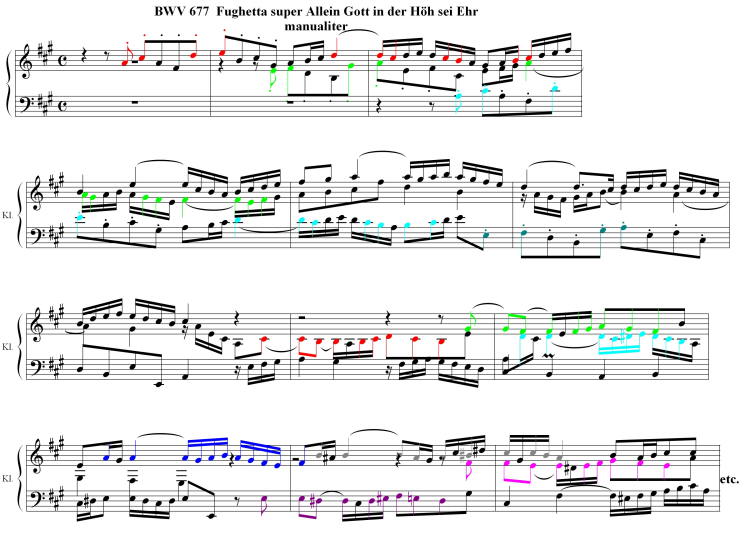
|
|
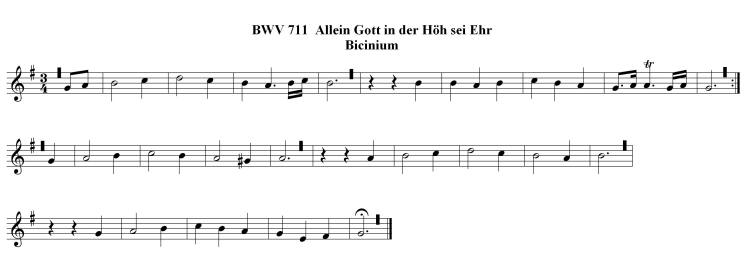
|
|

|
|

|
| |
|
Use of the Chorale Melody by other composers: |
|
Nikolaus Decius (1485-1546):
Aleyne God yn der Höge sy eere a 4-pt. setting for voices [This is the original Low German spelling of the title of this famous chorale] |
|
Leonhard Schröter (c1540-1595):
Allein Gott in der Höh sei Ehr, 4-pt. vocal setting (1587) |
|

|
|
Valentin Schumann (1st half of 16th Century?):
Allein Gott in der Höh sei Ehr, Chorales for voices |
|
Jan Pieterszoon Sweelinck (1562-1621):
Allein Gott in der Höh sei Ehr, chorale variations (4) for organ or keyboard instrument (with other composers) |
|
Hans Leo Hassler (1564-1612):
Allein Gott in der Höh sey ehr, 4 voices (1608) |
|
Michael Praetorius (1571-1621):
Allein Gott in der Höh sei Ehr a 12 (Musae Sioniae II, 1607), motet |
|
Johann Jeep (1582-1644):
Allein Gott in der Höh sei Ehr, 4-pt. vocal setting (1629) |
|
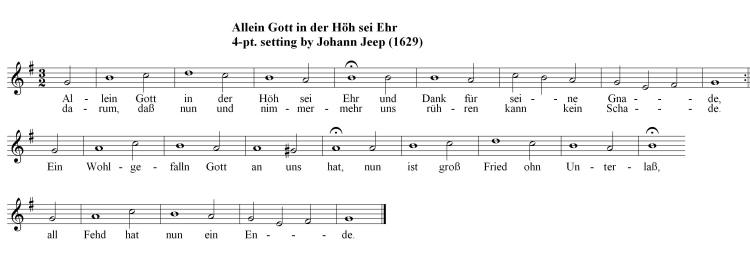
|
|
Peter Hasse (c1585-1640):
Two 3 part Organ Variations on Allein Gott in der Höh sei Ehr |
|
Heinrich Schütz (1585-1672):
Allein Gott in der Höh' sei Ehr, for 2 sopranos, 2 tenors & continuo, SWV 327 (Op. 9/22) (1639) |
|
Johann Hermann Schein (1586-1630):
Allein Gott in der Höh sei Ehr, cantata for 3 voices (SST) & continuo (Opella nova, Part 2, No. 3) (1626)
Allein Gott in der Höh sei Ehr, hymn for 4 voices (SATB) & continuo (Cantional...) (1627)
Ehr' sei Gott in der Höh' allein, motet for 10 voices (Cymbalum Sionium) ( 1615) ??? |
|
Samuel Scheidt (1587-1654):
Allein Gott in der Höh' sei Ehr', for organ
4-pt. setting of Allein Gott in der Höh sei Ehr, SSWV 559
4-pt. setting of Allein Gott in der Höh sei Ehr, SSWV 464
3-pt setting of Allein Gott in der Höh sei Her, STB, bc, SSWV 317 |
|
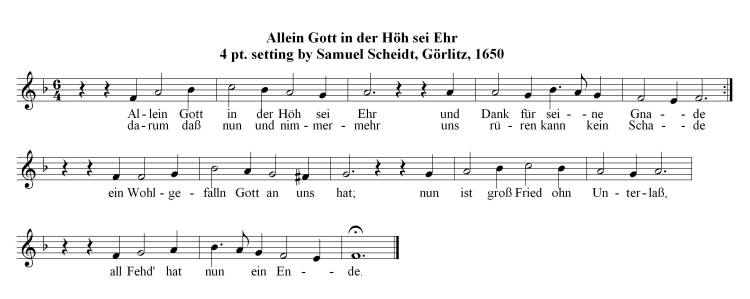
|
|
Johann Andreas Herbst [Autumnus] (1588-1666):
Cantatas, chorale concertos, motets (for 4 and 5 parts): Allein Gott in der Höh’, 9vv |
|
Melchior Schildt (1592/1593-1667):
Allein Gott in der Höh sei Ehr, Chorale Prelude for Organ/Keyboard |
|
Gottfried Scheidt (1593-1661):
Gottfried Scheidt, a brother of Samuel Scheidt, studied under J.P. Sweelinck in Amsterdam from 1611-1615 In 1614, he assembled a set of variations by himself, Sweelinck and others on Allein Gott in der Höh sei Ehr for organ or keyboard.
Allein Gott in der Höh sei Ehr, org (1614) (incl. 6 variations, 3 by Scheidt, 3 anon., perhaps by Scheidt), D-Bsb [collab. J.P. Sweelinck and others]; ed. H.J. Moser (Kassel, 1953); ed. G. Gerdes, 46 Choräle für Orgel von J.P. Sweelinck und seinen deutschen Schülern (Mainz, 1957) |
|
Andreas Düben (c1597-1662):
5 Chorale Prelude Variations for Organ on Allein Gott in der Höh sei Ehr |
|
Anonymous (Celle organ tablature of 1601):
Of great importance is the so-called Celle tablature of 1601 (now lost), the first known source of organ music from north Germany since the mid-15th century and containing about 75 chorale settings of which 61 survived, including compositions on Allein Gott in der Höh sei Ehr, Ach Gott vom Himmel sieh darein and Vater unser im Himmelreich. Most of the settings were anonymous; the only composer mentioned by name was Johann Stephan (Steffens). Again, the embellished chordal style familiar from the Ammerbach tablature is represented, but more ambitious compositions appeared in the Celle tablature too. |
|
Johannes Crüger (1598-1662):
Allein Gott in der Höh sei Ehr for 4 voices (SATB), 2 instruments, bc |
|
Wilhelm Karges (1613/1614-1699):
Pasticcio of Variations on Allein Gott in der Höh |
|
Sebastian Lemmle (fl. 1630's):
A „Concert à 21 (22) Vocibus in Echo à 4 Choris Allein Gott in der Höh' sei Ehr (composed for a performance on September 12, 1625)
Allein Gott in der Höhe sey Ehr 22 in Echo: ChI 2 Violins, 2 Violas, Violone: ChII SSATB; ChIII SATB; ChIV 2 Cornetti, 6 Trombones; Cappella SATB; Tiorbo, Violone, Organ (parts dated 1635) |
|
Crato Bütner (1616-1679):
Allein Gott in der Höh sei Ehr for 4 voices, violin (cornett), 2 violas.(trombones), Violone (positif) & bc (November 1677) |
|
Nikolaus Hasse (1617-1672):
Allein Gott in der Höh' sei Ehr, Chorale Prelude for organ |
|
Georg Caspar Wecker (1632-1695):
Cantata Allein Gott in der Höh sey Ehr for 6 voices, 4 strings, 2 trumpets, 2 trombones, bassoon, bc |
|
Christian Geist (1640-1711):
Allein Gott in der Höh' sei Ehr', for organ |
|
Johann Christoph Bach (1642-1703):
Allein Gott in der Höh sei Ehr, Chorale Prelude for Organ |
|
Johann Georg Conradi (1645-1699):
Allein Gott in der Höh sey Ehr, 6 voices (AATTBB), 2 flutes, 2 horns, trumpet, 2 violins, 2 violas, bc.in F; (attributed to Georg Caspar Wecker) |
|
Johann Michael Bach (1648-1694):
Allein Gott in der Höh sei Ehr, Chorale Prelude for Organ |
|
Johann Krieger (1652-1735) (brother of the more famous Krieger):
Allein Gott in der Höh sei Ehr, à 4 parts (instrumental parts) |
|
Johann Pachelbel (1653-1706):
Allein Gott in der Höh sei Ehr, Chorale Prelude for organ (I), T. 14 (also attrib. Johann Heinrich Buttstett)
Allein Gott in der Höh sei Ehr, Chorale Prelude for organ (II), T. 15 (also attrib. Johann Heinrich Buttstett) |
|
Christian Heinrich Aschenbrenner (1654-1732):
Allein Gott in der Höh sey Ehr for 4 voices and 6 instruments |
|
Georg Böhm (1661-1733):
Allein Gott in der Höh Sei Ehr, Chorale Prelude for Organ |
|
Friedrich Wilhelm Zachow [Zachau] (1663-1712):
Allein Gott in der Höh sei Ehr, for choir
Allein Gott in der Höh sei Ehr, Chorale Prelude for Organ |
|
Johann Heinrich Buttstett (1666-1727):
Chorale Partita Allein Gott in der Höh sei Ehr (1705)
Two Chorale Preludes for Organ on Allein Gott in der Höh sei Ehr (originally attributed to Johann Pachelbel) |
|
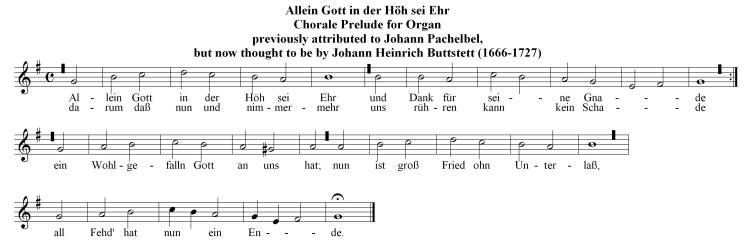
|
|
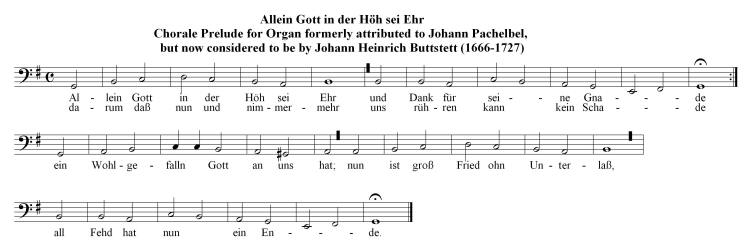
|
|
Nicolaus Vetter (1666-1734):
Allein Gott in der Höh sei Ehr, 1st setting for organ, 2 verses, ed. F. Dietrich, Elf Orgelchoräle des siebzehnten Jahrhunderts (Kassel, 1932)
Allein Gott in der Höh sei Ehr, 2nd setting for organ (chorale partita), 2 verses or perhaps all 17 attrib Bach, BWV 771; D-Bsb Bach P1143
Allein Gott in der Höh sei Ehr, 3rd setting for organ, 2 verses, NL-DHgm |
|
Johann Nicolaus Bach (1669-1753) (the Jena Bach, a cousin of Johann Sebastian):
Short Mass in E minor (edited by A. Fareanu 1920 and published by B & H ) has the chorale Allein Gott in der Höh sei Ehr“ embedded in the Gloria section |
|
Andreas Armsdorff (1670-1699):
Chorale Prelude (Trio) for Organ on Allein Gott in der Höh sei Ehr |
|
Wolfgang Förtsch (1675-1743):
Cantata Allein Gott in der Höh sei Ehr (1734) |
|
Johann Georg Reinhardt (1676/77-1742):
Christmas Cantata: Cantilena de Nativitate Domini Allein Gott in der Höh sey Ehr |
|
Johann Ludwig Bach (1677-1731):
Messe sopra cantilena Allein Gott in der Höh (1716), BWV Anh.III.166 [opening of Gloria by J.S. Bach] |
|
Georg Friedrich Kauffmann (1679-1735):
Allein Gott in der Höh' sei Ehr, chorale prelude for organ |
|
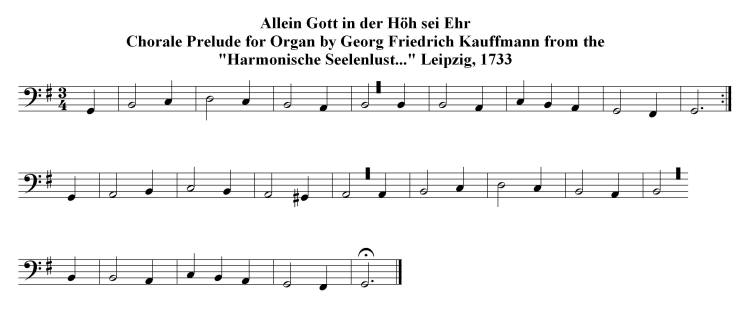
|
|
Georg Philipp Telemann (1681-1767):
Allein Gott in der Höh' sei Ehr', 2 Chorale preludes for organ in G major, TWV 31:3-4 (1735)
Allein Gott in der Hoh sei Ehr (I), sacred canfor voice, chorus, trumpet , 2 violins, viola & continuo, TWV 1:58
Allein Gott in der Hoh sei Ehr (II), chorale-cantata for 3-part chorus (SBB), 2 violins, viola & continuo, TWV 1:59 (1754)
Missa sopra Allein Gott in der Höh sei Ehr, for chorus (4 voices), 2 zink, 2 oboes, strings & bc, TWV 9:2 |
|
Johann Gottfried Walther (1684-1748):
Chorale Prelude on Allein Gott in der Höh sei Ehr from Harmonische Denck- und Dankmahl, bestehend aus VIII Vor-Spielen über das Lied: Allein Gott in der Höh sey Ehr, kbd (Augsburg, 1738) |
|
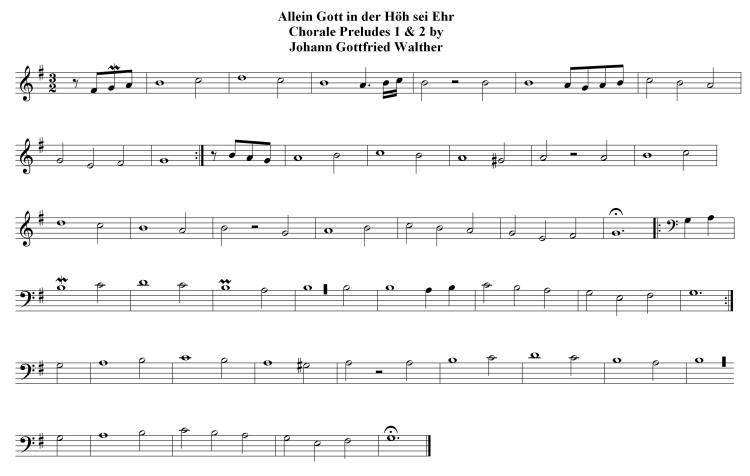
|
|
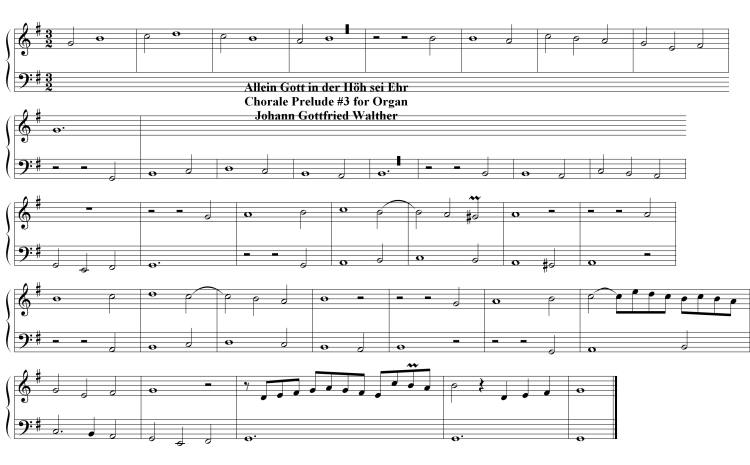
|
|

|
|
Johann Balthasar Christian Freißlich (1687-1764):
Chorale Allein Gott in der Höh sei Ehr for choir and instruments |
|
Johann Peter Kellner (1705-1772):
3 Chorale Variations for 2 Manuals and.Pedal Organ Allein Gott in der Höh sei Ehr |
|
Wilhelm Friedemann Bach (1710-1784):
Organ Trio on Allein Gott in der Höh sei Ehr (lost) |
|
Johann Ludwig Krebs (1713-1780):
Allein Gott in der Hösh Sei Ehr, Chorale Prelude for Organ
Allein Gott in der Höh sei Ehr, chorale for organ |
|
Gottfried August Homilius (1714-1785):
Allein Gott in der Hoh sei Ehr, Chorale Prelude for organ |
|
August Eduard Grell (1800-1886):
Organ music: Praeludium and Chorale Prelude on Allein Gott in der Höh (1826)
2 Chorale Preludes in G major on den Choral Allein Gott in der Höh (1826) from 15 Pieces/Compositions for Organ (1829/30) |
|
Felix Mendelssohn-Bartholdy (1809-1847):
Allein Gott in der Höh', chorale harmonization for chorus (September 1824)
Allein Gott in der Höh, chorale harmonization for chorus & winds [Chorale harmonizations (3) No. 1] (December 1843); performed Berlin, Christmas 1843 |
|
Immanuel Gottlob Friedrich Faißt (1823-1894):
Allein Gott in der Höh' for the Stuttgart Choral Society |
|
Emil Dercks (1849-1911):
Allein Gott in der Höh' sei Ehr', for organ |
|
Max Reger (1873-1916):
Allein Gott in der Höh' sei Ehr, Chorale Prelude for organ, Op. 67/1 (1902)
Allein Gott in der Höh' sei Ehr, Chorale Prelude for organ, Op. 135a/2 (1914) |
|
Arnold Schoenberg (1874-1951):
Allein Gott in der Höh' sei Ehr (N. Hovesch), chorale arrangement for alto, violin, cello & piano (1918-1925) |
|
Charles Tomlinson Griffes (1884-1920):
Allein Gott in der Höh' sei Ehr, Chorale Prelude for Organ, A. 104 (1910) |
|
Ernst Pepping (1901-1981):
Deutsche Choralmesse (1928) - a six-part setting of the Gloria and Credo chorales (Allein Gott in der Höh sei Ehr |
|
Herbert Gadsch (1913 - ?):
Allein Gott in der Höh Sei Ehr |
|
John Karl Hirten (? contemporary composer):
Allein Gott in der Höh sei Ehr, for organ (1990?) |
|
Aivars Kalējs (b 1951):
Toccata über de Allein Gott in der Höh' sei Ehr, for organ (after J. S. Bach) (1994-2000?) |
| |
|
Sources: NBA, vols. III/2.1 & 2.2 in particular [Bärenreiter, 1954 to present] and the BWV ("Bach Werke Verzeichnis") [Breitkopf & Härtel, 1998]
The PDF files of the Chorales were contributed by Margaret Greentree J.S. Bach Chorales
Software: Capella 2004 Software, version 5.1.
Prepared by Thomas Braatz & Aryeh Oron (April 2006) |
|
|